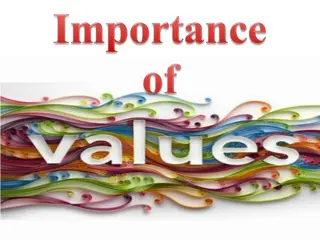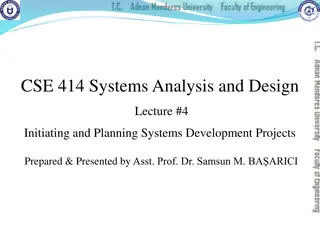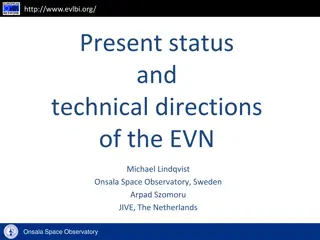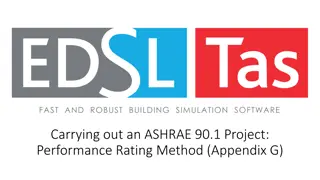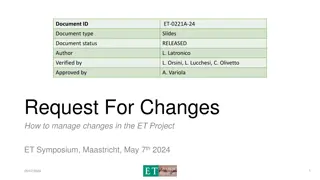Understanding the Significance of Establishing Baseline Values in Project Management
Baselines serve as crucial reference points in project evaluation and progress tracking. They help in setting realistic targets, interpreting performance data effectively, and enhancing evaluation findings. By establishing baselines, projects can measure success and make informed decisions towards achieving desired outcomes.
Download Presentation

Please find below an Image/Link to download the presentation.
The content on the website is provided AS IS for your information and personal use only. It may not be sold, licensed, or shared on other websites without obtaining consent from the author. Download presentation by click this link. If you encounter any issues during the download, it is possible that the publisher has removed the file from their server.
E N D
Presentation Transcript
M&E Concepts: Setting Baseline Values and Indicator Targets 2022 BUREAU OF INTERNATIONAL LABOR AFFAIRS
M&E Training Course Series Six Courses 1. Introduction to Results-Based Management 2. Designing Results Frameworks 3. Designing and Defining Performance Indicators 4. Developing Data Collection Tools 5. Setting Baseline Values and Indicator Targets 6. Using Data For Project Improvement https://www.dol.gov/agencies/ilab Office of Child Labor, Forced Labor, and Human Trafficking @ILAB_DOL
Training Objectives At the end the training, participants will have increased their understanding of: The methods and approaches for setting baseline values. How to establish realistic targets. https://www.dol.gov/agencies/ilab Office of Child Labor, Forced Labor, and Human Trafficking @ILAB_DOL
Agenda Establishing Baseline Target Setting https://www.dol.gov/agencies/ilab Office of Child Labor, Forced Labor, and Human Trafficking @ILAB_DOL
Establishing Baseline BUREAU OF INTERNATIONAL LABOR AFFAIRS
What is a Baseline? The value of an indicator before project implementation has started. Example of baseline values before implementation begins: Indicator Baseline % of beneficiaries that graduated from secondary school 20% 47% County literacy rate (Female: 30%; Male 60%) Number of training courses delivered 0 Number of households below poverty line 200 https://www.dol.gov/agencies/ilab Office of Child Labor, Forced Labor, and Human Trafficking @ILAB_DOL
Why are Baselines Useful? Help determine progress in achieving outputs and outcomes Enable effective interpretation of performance data Inform target setting for indicators Provide key point of comparison for evaluations and improves the conclusiveness of evaluation findings https://www.dol.gov/agencies/ilab Office of Child Labor, Forced Labor, and Human Trafficking @ILAB_DOL
Establishing a Baseline Baselines are either: Set to zero - frequently the case for project specific output indicators and some indicators of lower-level results Already known or determined - available from secondary sources, or prior projects Collected pre-implementation - primary data collection, rapid assessment, survey, etc. Rolling Baseline - activity is rolled out to different groups/regions at different times https://www.dol.gov/agencies/ilab Office of Child Labor, Forced Labor, and Human Trafficking @ILAB_DOL
Set to Zero Scenario When Example Number of investigators trained Set to Zero Common for output indicators for products and services offered for the first time Number of union meetings facilitated Number of beneficiaries that obtain new employment within 6 months https://www.dol.gov/agencies/ilab Office of Child Labor, Forced Labor, and Human Trafficking @ILAB_DOL
Baseline Already Established Scenario When Example Secondary school drop out rate (Ministry of Education) Baseline Already Established Baseline exists and can be obtained from secondary sources (e.g., government, business, donors) or from past project reports % of business inspected for labor violations last year (Ministry of Labor) Number of farmers reporting using child labor (prior project) https://www.dol.gov/agencies/ilab Office of Child Labor, Forced Labor, and Human Trafficking @ILAB_DOL
Collect pre-implementation Scenario When Example Institutional capacity of target NGOs Collect pre- implementation Secondary or past data do not exist; Primary data collection is required to establish baseline; Citizen perception of government involvement in labor rights Average income for target households https://www.dol.gov/agencies/ilab Office of Child Labor, Forced Labor, and Human Trafficking @ILAB_DOL
Rolling Baseline Scenario When Example Registry of beneficiaries by target province in different years Rolling Baseline An indicator has multiple baseline values and baseline dates; An activity is rolled out to different groups/regions at different times Average pre-test score of project participants by cohort https://www.dol.gov/agencies/ilab Office of Child Labor, Forced Labor, and Human Trafficking @ILAB_DOL
Target Setting BUREAU OF INTERNATIONAL LABOR AFFAIRS
What is a target? A target is the specific, planned level of result to be achieved within an explicit timeframe with a given level of resources. Targets are set for all project indicators. Indicator: Year Target Actual Baseline (2016) 0 0 Number of youth trained in vocational job skills 2017 10,000 8,500 2018 14,000 15,200 End of Project (2019) 16,000 16,700 https://www.dol.gov/agencies/ilab Office of Child Labor, Forced Labor, and Human Trafficking @ILAB_DOL
Why Set Targets? Communicate clear expectations and define success. Serve as the guideposts for planning and managing. Promote transparency and accountability. https://www.dol.gov/agencies/ilab Office of Child Labor, Forced Labor, and Human Trafficking @ILAB_DOL
Types of Targets Final Target: The expected value of an indicator and the end of a project (or some specific planning period). Interim Target: The expected value of an indicator for defined time periods, between the baseline year and the final target year (e.g., annually). Targets should be set based on indicator reporting periods (e.g. quarterly, annually, etc.) https://www.dol.gov/agencies/ilab Office of Child Labor, Forced Labor, and Human Trafficking @ILAB_DOL
How to set targets Step 1: Identify the baseline Step 2: Conduct analysis of relevant information Step 3: Document target values and reason selected https://www.dol.gov/agencies/ilab Office of Child Labor, Forced Labor, and Human Trafficking @ILAB_DOL
Step 1: Determine Baseline Define or identify the baseline What is the level of performance before the intervention? Baselines are either: Set to zero Already known or determined Collected pre-implementation Rolling Baseline https://www.dol.gov/agencies/ilab Office of Child Labor, Forced Labor, and Human Trafficking @ILAB_DOL
Step 2: Conduct Analysis Conduct Analysis of Relevant Information: a) b) c) d) Consider your intervention Review historical trends of the data Benchmark Research and expert opinion https://www.dol.gov/agencies/ilab Office of Child Labor, Forced Labor, and Human Trafficking @ILAB_DOL
Step 2a: Consider Your Intervention Consider this indicator/target in relation to other indicators and targets Targets Indicators Results Chain # of supervisors observed using improved labor practices ??? Increased use of improved labor practices Increased knowledge of labor practices by private sector actors # of supervisors who can identify 4 or more good labor practices 1,200 # of supervisors trained on improved labor practices 2,000 Trained supervisors in labor practice https://www.dol.gov/agencies/ilab Office of Child Labor, Forced Labor, and Human Trafficking @ILAB_DOL
Step 2a: Consider Your Intervention (cont.) Consider the pace of the change: When will you be implementing different components of your intervention? How many beneficiaries can you target in each year with the resources you have? Targets for number of Teachers Trained (Interim) Targets for number of Teachers Trained (Cumulative) 1000 830 780 400 800 300 250 300 530 600 180 200 400 Baseline = 0 230 50 50 100 200 50 0 0 2014 2015 2016 2017 2018 2019 2014 2015 2016 2017 2018 2019 https://www.dol.gov/agencies/ilab Office of Child Labor, Forced Labor, and Human Trafficking @ILAB_DOL
Step 2b: Historical Trends and Forecasting Percentage of children attending secondary schools 60 Baseline Use historic data to estimate a future trend, then add the value added by the intervention s activities. 50 40 30 20 10 ??? 0 2002 2003 2004 2005 2006 2007 2008 https://www.dol.gov/agencies/ilab Office of Child Labor, Forced Labor, and Human Trafficking @ILAB_DOL
Step 2c: Benchmarking Compare against similar programs and activities. Look at the achievement of other similar programs both within DOL and by other donor agencies. Look across similar context and indicators. Consider parallel experience from other countries. https://www.dol.gov/agencies/ilab Office of Child Labor, Forced Labor, and Human Trafficking @ILAB_DOL
Step 2d: Research and Expert Opinion Review development research, literature focusing on evaluations and studies of relevant sectors, programs and projects. Think about external conditions that may affect indicator values over time (e.g., conflict, drought). Engage with technical experts, partners, program staff and beneficiaries about: What is possible and reasonable with respect to a particular indicator and country setting? What factor may influence (positively or negatively) the level of targets? https://www.dol.gov/agencies/ilab Office of Child Labor, Forced Labor, and Human Trafficking @ILAB_DOL
Step 3: Document Target Document Target Values and Reasons Selected Document and file information on how/why you set the target values, to serve as a reference for: - Analyzing actual performance data - Setting targets in later years - Responding to inquiries or audits https://www.dol.gov/agencies/ilab Office of Child Labor, Forced Labor, and Human Trafficking @ILAB_DOL
Setting Targets is Tricky Remember Don t set an indicator target in isolation. Consider targets in relation to targets of other indicators up and down the results chain. Consider interim targets in relation to the expected pace of change. Even the best analysis rarely captures all eventualities. Be sure to consult technical experts, partners, implementers, etc. The higher up the framework, the lower the project s direct influence and targets become more tenuous. 26 https://www.dol.gov/agencies/ilab Office of Child Labor, Forced Labor, and Human Trafficking @ILAB_DOL
Setting Targets is Tricky (continued) Remember Don t get stuck on a single target value, start with the feasible set of possible indicator values. Consider a target range which allows for reasonable fluctuations of performance. Patterns of change/progress are hard to predict. https://www.dol.gov/agencies/ilab Office of Child Labor, Forced Labor, and Human Trafficking @ILAB_DOL
Common Pitfalls The following are the most common pitfalls in setting targets: Lack of analysis Lack of consultation Assuming that progress is a straight line Lack of readjustment over time https://www.dol.gov/agencies/ilab Office of Child Labor, Forced Labor, and Human Trafficking @ILAB_DOL
Assessing Targets Is the target ambitious enough? Is the target achievable given the resources needed to achieve it? If for a lower-level result, is the target sufficient to drive higher level results/targets? Are there external contextual factors that would affect the achievement of this target? If assessing the target during the life of the strategy or project, has the target been reviewed/adjusted since it was initially set? https://www.dol.gov/agencies/ilab Office of Child Labor, Forced Labor, and Human Trafficking @ILAB_DOL
Knowledge Check BUREAU OF INTERNATIONAL LABOR AFFAIRS
Question 1: Which of the following is NOT a benefit of collecting baseline data? Help setting targets Help select performance indicators Help interpret performance over the life of a project https://www.dol.gov/agencies/ilab Office of Child Labor, Forced Labor, and Human Trafficking @ILAB_DOL
Question 2: Which of the following is NOT a potential consideration when setting targets? Historical data and trends Expected pace of project implementation Expert opinions Past performance of similar projects Whether data can be collected https://www.dol.gov/agencies/ilab Office of Child Labor, Forced Labor, and Human Trafficking @ILAB_DOL
Question 3: ILAB only requires grantees to propose targets for output level indicators, because targets for indicators at the outcome and project objective levels are too hard to set. True False https://www.dol.gov/agencies/ilab Office of Child Labor, Forced Labor, and Human Trafficking @ILAB_DOL
Question 4: Grantees that meet their targets are great performers and those that miss their targets are poor performers. True False https://www.dol.gov/agencies/ilab Office of Child Labor, Forced Labor, and Human Trafficking @ILAB_DOL
Conclusion BUREAU OF INTERNATIONAL LABOR AFFAIRS
Baseline Summary Baselines are either: Set to zero Already known or determined Collected pre-implementation Rolling Baseline https://www.dol.gov/agencies/ilab Office of Child Labor, Forced Labor, and Human Trafficking @ILAB_DOL
Target Setting Summary The Benefits of Targets: Targets define a shared set of expectations around project success for project staff, partners and stakeholders. Targets help us judge performance and manage the project. Targets bring the objectives of the project into sharp focus and orient staff and partners to a very specific goal. The Overall Steps for Target Setting: Step 1: Identify the baseline Step 2: Conduct analysis of relevant information Step 3: Document target values and reason selected https://www.dol.gov/agencies/ilab Office of Child Labor, Forced Labor, and Human Trafficking @ILAB_DOL
Resources https://www.dol.gov/sites/dolgov/files/ILAB/MandE-Resource-Guide-for-OCFT-Projects-508-Compliant-Version.pdf Monitoring and Evaluation Resource Guide OCFT Projects: https://www.dol.gov/sites/dolgov/files/ILAB/MandE-Resource-Guide-for-OCFT-Projects- 508-Compliant-Version.pdf https://www.dol.gov/sites/dolgov/files/ILAB/MandE-Resource-Guide-for-OCFT-Projects-508-Compliant-Version.pdf Monitoring Toolkit-Performance Indicator Targets (usaidlearninglab.org) USAID Performance indicator targets: Monitoring Toolkit-Performance Indicator Targets Monitoring Toolkit-Performance Indicator Targets (usaidlearninglab.org) (usaidlearninglab.org) USAID Target Setting Guide: Target Setting Guide (usaid.gov) Target Setting Guide (usaid.gov) https://www.dol.gov/agencies/ilab Office of Child Labor, Forced Labor, and Human Trafficking @ILAB_DOL
THANK YOU 39 https://www.dol.gov/agencies/ilab Office of Child Labor, Forced Labor, and Human Trafficking @ILAB_DOL






